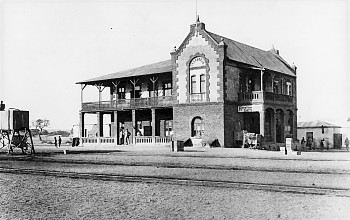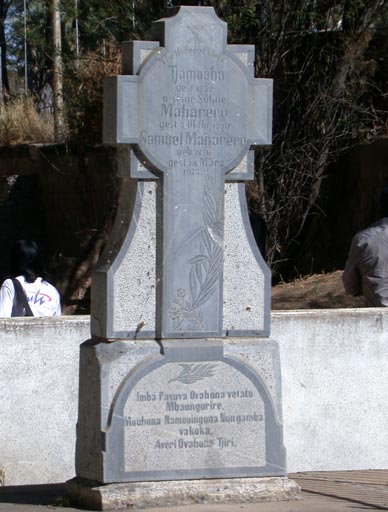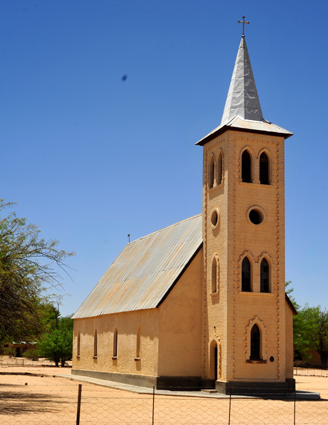|
Okahandja
Okahandja is a city of 24,100 inhabitants in Otjozondjupa Region, central Namibia, and the district capital of the Okahandja electoral constituency. It is known as the ''Garden Town of Namibia''. It is located 70 km north of Windhoek on the B1 road. It was founded around 1800, by two local groups, the Herero and the Nama. History Okahandja means ''the place where two rivers'' (Okakango and Okamita) ''flow into each other to form one wide one'' in Otjiherero. A German pastor, Heinrich Schmelen, became the first European to visit the town in 1827. In 1844, two missionaries were permanently assigned to the town, Heinrich Kleinschmidt and Hugo Hahn. A church dates from this period. A military post was established at the initiative of Theodor Leutwein in 1894, and it is this date that is officially recognized as the town's founding.Okahandja Hi ... [...More Info...] [...Related Items...] OR: [Wikipedia] [Google] [Baidu] |
B1 Road (Namibia)
The B1 is a national highway of Namibia, and is the country's longest and most significant road, running the length of the country from south to north. It connects Noordoewer in the south on the South African border with Oshikango in the north on the Angolan border via Namibia's capital city Windhoek. The route exists in two discontinuous sections: a southern section from Noordoewer to Windhoek, and a northern section from Okahandja to Oshikango. The central section between Windhoek and Okahandja, previously part of the B1, was upgraded to freeway standard beginning in the 1970s and continuing to 2022, with the freeway sections now carrying the designation of A1. The entirety of the B1, together with the former section of B1 now designated A1, forms part of the Tripoli-Cape Town Highway. The section between Okahandja and Otavi is part of the Walvis Bay-Ndola-Lubumbashi Development Road, and the former section of B1 now designated A1 from Okahandja to Windhoek forms part ... [...More Info...] [...Related Items...] OR: [Wikipedia] [Google] [Baidu] |
Maharero Monument Okahandja
Maharero kaTjamuaha (Otjiherero: ''Maharero, son of Tjamuaha'', short: Maharero; 1820 – 7 October 1890) was one of the most powerful paramount chiefs of the Herero people in South-West Africa, today's Namibia. Early life Maharero, was born about 1820 at Okahandja. In 1843 he went with his father Tjamuaha to Windhoek to stay with Jonker Afrikaner, Captain of the Oorlam Afrikaners. Tjamuaha was an ally of Jonker Afrikaner until his death in 1861, albeit in a subordinate position. Maharero a leader of Ovaherero community in (1861-1890) was born in ca 1820 at Otjikune near Okahandja and he was the son of Tjamuaha and his chief wife Tjorozumo. He had several brothers and half-brothers, amongst them were Kavezeri, Kariteova, Kavikunua and Rijarua. Like his father, Maharero became an ally of Jonker Afrikaner in 1843. As from 1863 onwards, he refused to accept the dominance of the Afrikaners and was recognized by both Herero’s and the European in the country as the representat ... [...More Info...] [...Related Items...] OR: [Wikipedia] [Google] [Baidu] |
Maharero
Maharero kaTjamuaha ( Otjiherero: ''Maharero, son of Tjamuaha'', short: Maharero; 1820 – 7 October 1890) was one of the most powerful paramount chiefs of the Herero people in South-West Africa, today's Namibia. Early life Maharero, was born about 1820 at Okahandja. In 1843 he went with his father Tjamuaha to Windhoek to stay with Jonker Afrikaner, Captain of the Oorlam Afrikaners. Tjamuaha was an ally of Jonker Afrikaner until his death in 1861, albeit in a subordinate position. Maharero a leader of Ovaherero community in (1861-1890) was born in ca 1820 at Otjikune near Okahandja and he was the son of Tjamuaha and his chief wife Tjorozumo. He had several brothers and half-brothers, amongst them were Kavezeri, Kariteova, Kavikunua and Rijarua. Like his father, Maharero became an ally of Jonker Afrikaner in 1843. As from 1863 onwards, he refused to accept the dominance of the Afrikaners and was recognized by both Herero’s and the European in the country as the repre ... [...More Info...] [...Related Items...] OR: [Wikipedia] [Google] [Baidu] |
Clemens Kapuuo
Clemens Kapuuo (16 March 1923 – 27 March 1978) was a Namibian school teacher, shopkeeper, president of the Democratic Turnhalle Alliance (DTA), now called Popular Democratic Movement (PDM), and chief of the Herero people of Namibia. Kapuuo was one of the leading opponents of South African rule of his country until his assassination following the Turnhalle Constitutional Conference. Biography Clemens Kapuuo was born in 1923 at Ozondjona za Ndjamo (''Teufelsbach''), in the Okahandja District north of Windhoek and attended school at Okahandja in 1931. In 1937 he went to St Barnabas Anglican Church School in Windhoek's Old Location. He qualified as a teacher at Viljoensdrif and at the Stoffberg Training College, both in the Orange Free State (province), Orange Free State. Kapuuo was related to Samuel Maharero, Samuel Maherero and was also the blood nephew of the first Namibian nationalist leader, Hosea Kutako. From 1944 to 1945 he taught at primary schools in Waterberg and Karib ... [...More Info...] [...Related Items...] OR: [Wikipedia] [Google] [Baidu] |
Otjozondjupa Region
Otjozondjupa is one of the fourteen regions of Namibia. Its capital is Otjiwarongo. The region further contains the municipalities of Okahandja and Grootfontein and the towns Okakarara and Otavi. , Otjozondjupa had 97,945 registered voters. Geography A landmark within this region is the Waterberg Plateau Park. Twenty four kilometres west of Grootfontein lies the huge Hoba meteorite. At over 60 tons, it is the largest known meteorite on Earth, as well as being the largest naturally occurring mass of iron known to exist on the planet's surface. In the east, Otjozondjupa borders the North-West District of Botswana. Domestically, it borders more regions than any other region of Namibia: * Omaheke – southeast * Khomas – south * Erongo – southwest * Kunene – northwest *Oshikoto – north * Kavango – northeast Economy and infrastructure Otjiwarongo, Grootfontein, Otavi, and Okahandja are linked by rail and by the main B1 and B8 trunk roads running from south to north ... [...More Info...] [...Related Items...] OR: [Wikipedia] [Google] [Baidu] |
Otjozondjupa
Otjozondjupa is one of the fourteen regions of Namibia. Its capital is Otjiwarongo. The region further contains the municipalities of Okahandja and Grootfontein and the towns Okakarara and Otavi. , Otjozondjupa had 97,945 registered voters. Geography A landmark within this region is the Waterberg Plateau Park. Twenty four kilometres west of Grootfontein lies the huge Hoba meteorite. At over 60 tons, it is the largest known meteorite on Earth, as well as being the largest naturally occurring mass of iron known to exist on the planet's surface. In the east, Otjozondjupa borders the North-West District of Botswana. Domestically, it borders more regions than any other region of Namibia: *Omaheke – southeast *Khomas – south *Erongo – southwest * Kunene – northwest *Oshikoto – north * Kavango – northeast Economy and infrastructure Otjiwarongo, Grootfontein, Otavi, and Okahandja are linked by rail and by the main B1 and B8 trunk roads running from south to north. Comm ... [...More Info...] [...Related Items...] OR: [Wikipedia] [Google] [Baidu] |
Von Bach Dam
The Von Bach Dam (originally the Sartorius von Bach Dam) is a rock-fill embankment dam on the Swakop River near Okahandja in the Otjozondjupa Region of Namibia. Built in 1968 and commissioned in 1970, the dam provides Namibia's capital of Windhoek Windhoek (, , ) is the capital and largest city of Namibia. It is located in central Namibia in the Khomas Highland plateau area, at around above sea level, almost exactly at the country's geographical centre. The population of Windhoek in 202 ... with much of the city's water. It also supplies Okahandja. The dam has a capacity of . Water from the reservoir is sent directly to a water treatment plant downstream. The treatment plant was completed in 1971 and upgraded in 1997. References Okahandja Dams in Namibia Buildings and structures in Otjozondjupa Region Dams completed in 1970 1970 establishments in South West Africa {{Africa-dam-stub ... [...More Info...] [...Related Items...] OR: [Wikipedia] [Google] [Baidu] |
Hugo Hahn
Carl Hugo Hahn (1818–1895) was a Baltic German missionary and linguist who worked in South Africa and South-West Africa for most of his life. Together with Franz Heinrich Kleinschmidt, he set up the first Rhenish mission station to the Herero people in Gross Barmen. Hahn is known for his scientific work on the Herero language. Early life Hahn was born into a bourgeois family on 18 October 1818 in Ādaži (Aahof) near Riga in the Russian Empire. He studied Engineering at the Engineering School of the Russian Army from 1834 onwards but was not satisfied with that choice and, more generally, his parents' way of life. In 1837 he left Ādaži for Barmen (today part of Wuppertal, Germany) to apply at the missionary school of the Rhenish Missionary Society. He was admitted to the Missionary School in Elberfeld (also part of Wuppertal today) in 1838 and graduated in 1841. Missionary work Hahn arrived in Cape Town on 13 October 1841. His orders were to bring Christianity to the Na ... [...More Info...] [...Related Items...] OR: [Wikipedia] [Google] [Baidu] |
Namibia
Namibia (, ), officially the Republic of Namibia, is a country in Southern Africa. Its western border is the Atlantic Ocean. It shares land borders with Zambia and Angola to the north, Botswana to the east and South Africa to the south and east. Although it does not border Zimbabwe, less than 200 metres (660 feet) of the Botswanan right bank of the Zambezi River separates the two countries. Namibia gained independence from South Africa on 21 March 1990, following the Namibian War of Independence. Its capital and largest city is Windhoek. Namibia is a member state of the United Nations (UN), the Southern African Development Community (SADC), the African Union (AU) and the Commonwealth of Nations. The driest country in sub-Saharan Africa, Namibia has been inhabited since pre-historic times by the San, Damara and Nama people. Around the 14th century, immigrating Bantu peoples arrived as part of the Bantu expansion. Since then, the Bantu groups, the largest being the Ovambo, h ... [...More Info...] [...Related Items...] OR: [Wikipedia] [Google] [Baidu] |
Hosea Kutako
Chief Hosea Katjikururume Komombumbi Kutako (1870 – 18 July 1970), was an early Namibian nationalist leader and a founder member of Namibia's first nationalist party, the South West African National Union (SWANU). "During his life, he experienced the transition from independence to colonization, and the destruction of Herero society and the loss of its lands, although he struggled to regain the freedom and self-determination that he and his society had previously known. Initially Kutako campaigned only for his own people, yet at a very early stage he began campaigning for the freedom and self-determination of all the inhabitants of Namibia. In this, Hosea Kutako can be described as the country’s first truly nationalist politician, a man who strove for the greater good not only for himself but for all. Hosea Kutako was born as a Herero royal, but into a position which, but for the course of history, would never have enabled him to claim lead ... [...More Info...] [...Related Items...] OR: [Wikipedia] [Google] [Baidu] |
Windhoek
Windhoek (, , ) is the capital and largest city of Namibia. It is located in central Namibia in the Khomas Highland plateau area, at around above sea level, almost exactly at the country's geographical centre. The population of Windhoek in 2020 was 431,000 which is growing continually due to an influx from all over Namibia. Windhoek is the social, economic, political, and cultural centre of the country. Nearly every Namibian national enterprise, governmental body, educational and cultural institution is headquartered there. The city developed at the site of a permanent hot spring known to the indigenous pastoral communities. It developed rapidly after Jonker Afrikaner, Captain of the Orlam, settled there in 1840 and built a stone church for his community. In the decades following, multiple wars and armed hostilities resulted in the neglect and destruction of the new settlement. Windhoek was founded a second time in 1890 by Imperial German Army Major Curt von François, wh ... [...More Info...] [...Related Items...] OR: [Wikipedia] [Google] [Baidu] |
Constituencies Of Namibia
Each of the 14 regions of Namibia is further subdivided into electoral constituencies. The size of the constituencies varies with the size and population of each region. There are currently 121 constituencies in Namibia. The most populous constituency according to the 2011 census was Rundu Urban in the Kavango West region with 63,431 people; the least populous was Okatyali in the Oshana region with 3,187 people. The administrative division of Namibia is tabled by '' Delimitation Commissions'' and accepted or declined by the National Assembly. In 1992, the First Delimitation Commission chaired by Judge President Johan Strydom determined the number of constituencies to be 95. Since then, every Delimitation Commission has increased this number to accommodate population growth. The fourth Delimitation Commission increased the number of constituencies to its present number in 2013. Local councillors are directly elected through secret ballots (regional elections) by the inhabitants ... [...More Info...] [...Related Items...] OR: [Wikipedia] [Google] [Baidu] |




.jpg)

